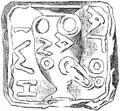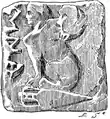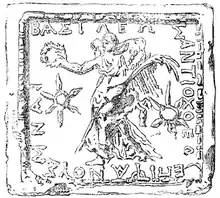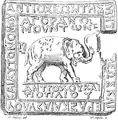Mina (unit)
The mina (also mĕnē, Aramaic; Hebrew: מָנֶה)[lower-alpha 1] is an ancient Near Eastern unit of weight, which was divided into 60 shekels. The mina, like the shekel, was also a unit of currency.
History
The word mina comes from the ancient Semitic root m-n-w/m-n-y 'to count',[1] Akkadian manû,[2] Hebrew: מָנָה (mana), Aramaic: מָנָה/מְנָא (mana/mena),[3] Classical Syriac: ܡܢܳܐ (mena),[4] Ugaritic: 𐎎𐎐, romanized: mn. It is mentioned in the Bible, where Solomon is reported to have made 300 shields, each with 3 "mina" of gold (Hebrew: מָנֶה, romanized: mane),[5] or later after the Edict of Cyrus II of Persia the people are reported to have donated 5000 mina of silver for the reconstruction of Solomon's Temple in Jerusalem.[6]
From earliest Sumerian times, a mina was a unit of weight. At first, talents and shekels had not yet been introduced. By the time of Ur-Nammu (shortly before 2000 BCE), the mina had a value of 1⁄60 talents as well as 60 shekels. The weight of this mina is calculated at 1.25 pounds (0.57 kg).[7][8]
Writings from Ugarit give the value of a mina as equivalent to fifty shekels.[9] The prophet Ezekiel refers to a mina (maneh in the King James Version) also as 60 shekels, in the Book of Ezekiel 45:12. Jesus of Nazareth tells the "parable of the minas" in Luke 19:11–27, also told with the talent unit of weight in Matthew. In Jewish usage, the maneh is equal in weight to 100 denarii.[10]
From the Akkadian period, 2 mina was equal to 1 sila of water (cf. clepsydra, water clock).
In ancient Greece, it originally equalled 70 drachmae and later was increased to 100 drachmae.[11] The Greek word mna (μνᾶ) was borrowed from Semitic;[12][13] compare Hebrew māneh, Aramaic mĕnē, Syriac manyā, Ugaritic mn, and Akkadian manū.
The Greek mina
The Aeginetan mina weighed 623.7 g (22.00 oz).[14]
The Attic mina weighed 436.6 g (15.40 oz).[15]
Purchasing power
- The price for a slave in Plautus' Pseudolus (191 BCE) was 20 minae; one mina being, according to the commentator writing in 1912, "about US$18.05, or £3 14s. 4d."[16] US$18.05 in 1912 would be equivalent to $507 in 2021.[17]
- In the first century AD [in Greece?], it amounted to about a fourth of the wages earned annually by an agricultural worker.
Images
 Mina of Athens.
Mina of Athens. Mina of Chios.
Mina of Chios. Mina of Antiochus IV Epiphanes.
Mina of Antiochus IV Epiphanes. Mina of Antioch.
Mina of Antioch.
Notes
- In the Hebrew tradition, a maneh had always the weight of 100 silver denarii.
References
- "mina", The American Heritage Dictionary of the English Language
- "manû", Akkadian Dictionary, Association Assyrophile de France
- Jastrow, Marcus (1903), Dictionary of the Targumim, Talmud Bavli, Talmud Yerushalmi and Midrashic Literature מְנֵי [Mənei], London, W.C.: Luzac & Co. ; New York: G. P. Putnam's Sons
- "Search Entry" ܡܢܵܐ ['mna], Sureth dictionary, Association Assyrophile de France
- 1 Kings 10:17.
- Ezra 2:69.
- Edwards, Tom. "Bible Weights, Measures, and Monetary Values". SpiritRestoration.org. Archived from the original on 21 January 2012. Retrieved 28 November 2008.. Calculation of weight by number of shekels.
-
 Singer, Isidore; et al., eds. (1901–1906). "Money". The Jewish Encyclopedia. New York: Funk & Wagnalls.
Singer, Isidore; et al., eds. (1901–1906). "Money". The Jewish Encyclopedia. New York: Funk & Wagnalls. - Tenney, Merril ed., The Zondervan Pictorial Encyclopedia of the Bible, vol. 5, "Weights and Measures," Grand Rapids, MI: Zondervan, 1976.
- Maimonides (1974). Sefer Mishneh Torah - HaYad Ha-Chazakah (Maimonides' Code of Jewish Law) (in Hebrew). Vol. 4 (Seder Avodah). Jerusalem: Pe'er HaTorah., s.v. Hil. Kelei HaMikdash 2:3
- Aristotle (unknown date). Constitution of the Athenians, 10.2.
- Jastrow, Marcus (1903). Dictionary of the Targumim, Talmud Bavli, Talmud Yerushalmi and Midrashic Literature. London, W.C.: Luzac & Co. ; New York: G. P. Putnam's Sons.
- Henry George Liddell; Robert Scott (1940). A Greek–English Lexicon. Oxford: Clarendon Press.
- Oleson (1998), p. 764
- Oleson (1998), p. 764
- Perseus Project Ps.1.3
- 1634–1699: McCusker, J. J. (1997). How Much Is That in Real Money? A Historical Price Index for Use as a Deflator of Money Values in the Economy of the United States: Addenda et Corrigenda (PDF). American Antiquarian Society. 1700–1799: McCusker, J. J. (1992). How Much Is That in Real Money? A Historical Price Index for Use as a Deflator of Money Values in the Economy of the United States (PDF). American Antiquarian Society. 1800–present: Federal Reserve Bank of Minneapolis. "Consumer Price Index (estimate) 1800–". Retrieved April 16, 2022.
Bibliography
- Oleson, John Peter (2008). The Oxford Handbook of Engineering and Technology in the Classical World. Oxford University Press. ISBN 9780199734856.